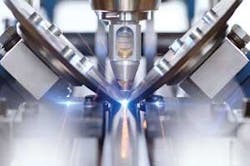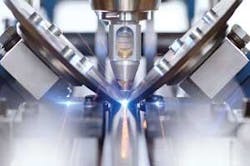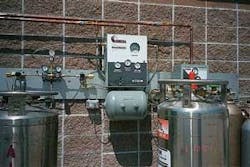GMAW-laser has its rewards
Improve your cost position with hybrid laser welding
Richard Green
In today’s highly competitive auto-motive market there is a need for speed. On the consumer side, it relates to horsepower.
In manufacturing, however, speed is all about throughput and productivity. American automotive manufacturers are losing market share for a chassis full of reasons, including styling, perceived quality, and cost of ownership.
Though a discussion of style is beyond the scope of this article, strategies to enhance quality and productivity are right on the mark. Both can be achieved by the hybrid process of laser welding combined with traditional gas metal arc welding (GMAW).
Laser variables such as wavelength, beam quality, beam spot size, power density, depth of focus, and beam placement are critical to success. Other parameters include the complementary conventional or pulse transfer GMAW energy source, GMAW wire placement, angle of impingement, and wire chemistry. Base material oxide surface condition, joint design, gap width, and shielding gas type and flow also contribute to the quality and performance of the hybrid process.
What follows here details the effect of gas selection on laser beam interaction, shielding effectiveness, bead characteristic, and the equipment required to deliver the correct gas mixture and flow.
The hybrid laser process incorporates a secondary energy source to the weld pool area. The hybrid process embodies the laser welding benefits of increased travel speeds, limited heat affected zone (HAZ), narrow weld joint, and excellent bead appearance. GMAW as a secondary energy source improves overall process energy efficiency, lowers fit up cost with enhanced ability to bridge gaps, slows cooling rates, and improves energy coupling efficiency of aluminum.
Even though the set up is more complicated, the lower base cost of the GMAW power supply reduces the total machine cost by reducing the size of the resonator needed to perform the weld. The GMAW wire feed may be located before or after the laser beam depending on the desired results. Higher welding speeds are typically achieved with a trailing GMAW wire feed (see Figure 1). The GMAW wire is fed into the laser-induced molten weld pool, requiring lower secondary power supply energy input to melt the wire.
In addition, the GMAW arc creates plasma and vaporizes the base material to create concavity in the front edge of the weld pool as the filler wire fills the trailing edge. This dimple in the molten weld pool reduces the overall depth the laser beam must penetrate to improve penetration.
It has been well documented that laser beam attenuation (scattering and absorption) from vapor particles evacuating the key hole or weld area reduce the amount of beam energy coupled to the base material.1 Scattering and absorption of the laser beam reduce the travel speed and depth of the weldment.2 Greses determined the larger the particles the greater the attenuation effect.
Figure 2 illustrates the particle size for both argon and helium shielding atmospheres.2 Helium shielding gas produced the smallest average vapor particle size. This suggests that pure helium is the best choice to control the vapor particle size for CO2 or Nd:YAG laser welding. Granted, helium does have higher ionization and lower plasma formation potential than argon but has a lighter molecular weight. Therefore, the helium shielding gas requires a greater flow rate to effectively evacuate the metal vapor out of the laser beam path. This increases the average cost per foot of weld based on helium’s high unit cost as compared to argon.
To optimize the shielding gas for plasma suppression, vapor particle evacuation, and unit cost, a mixture of up to 40-50 percent argon should be considered. The heavier mixture requires less flow to evacuate the vapor particles. The mixture also provides an inert atmosphere for a longer duration as the weld pool solidifies, enabling greater travel speeds. The hybrid process benefits from the additional energy supplied by the GMAW process to slow solidification rates. It also reduces the amount of trapped gases to lessen scrap rate from porosity.
Additionally, the slower solidification rates facilitate grain growth and relaxation of internal stresses, which increase fatigue strength. Weld cracking caused by the high aspect ratio (weld depth-to-width) and subsequent joint stresses are all but eliminated because of the additional weld face width that results from the addition of the GMAW filler metal.
Figure 3 illustrates the shielding efficiency and travel speed as a function of N2 (ppm) level in the weldment. This data was produced as part of an Air Liquide test in nozzle design.3 Assuming that all parameters are equal, it can be inferred that a mixture of helium and argon enable higher productivity while maintaining weld integrity.
Bead characteristics can further be enhanced by properly selecting minor additions of carbon dioxide and/or oxygen to the mixture or supplied as a secondary shielding gas for the GMAW process. Helium-argon mixtures tend to produce higher arc voltages, which subsequently yield wider bead profiles and greater arc instability.
For this reason, 3-10 percent carbon dioxide can be added to stabilize the transfer and constrict the arc. In some cases 1-5 percent oxygen may be added to achieve superior arc stability and better tie-in (wetting) at the weld edge. Oxygen tends to provide a wider but shallower penetration profile as compared to carbon dioxide mixtures based on its lower ionization and higher thermal conductivity properties.
Once the mixture has been specified to obtain the desired quality and productivity standards, the gas must be economically delivered to the use point. Mixing the shielding gas on-site enables the user to take advantage of lower-cost liquid argon supply modes. Why pay pre-mixed high-pressure helium cylinder prices for argon, carbon dioxide, or oxygen?
Argon can be delivered economically via liquid cylinders for monthly consumptions up to 35,000 cubic feet. This equates to a monthly mixed gas total usage of 87,500 cubic feet. Greater monthly argon usage may require bulk supply to achieve the optimum cost position. Considerations such as fill-loss, monthly facility fees, contractual bulk supply restrictions, and delivery charges must be factored into the analysis.
Helium, on the other hand, is typically supplied via high-pressure tube trailers or clusters. Onsite mixing requires a blender system capable of accurate adjustment from 0-100 percent of the minor components (see Figure 4). A total quality system can be achieved by placing an analyzer on the outlet of the blender to monitor and provide a warning if the mix ratio is out of tolerance. Software and alarm systems are available to provide this information to a local desktop computer as well as remotely via fax or e-mail.
A properly designed hybrid laser gas delivery system will allow the user to realize higher travel speeds and subsequently greater productivity. Attention to shielding gas variables such as type, flow, and angle of impact will enhance weld quality and reduce beam absorption and scattering effects.
Continued development of complementary welding methods that join processes such as GMAW to laser allows users to realize the benefits of both.
Richard Green is product manager for CONCOA, Virginia Beach, VA. Contact him via e-mail at [email protected] or visit www.concoa.com.
References
- A. Matsunawa and T. Ohnawa, “Beam-Plume Interaction in Laser Materials Processing,” Trans. JWRI 21, 1 (1991).
- J Greses, P.A. Hilton, C.Y. Barlow, and W. M. Steen, “Plume attenuation under high power Nd:yttritium-aluminum-garnet laser welding,” J. Laser Appl. Vol. 16, 1 (2004).
- F. Briand, K. Chouf, E. Verna, G. Caillibotte, and C. Caristan, “Front and Back Gas Shieldings for CO2 Laser Welding,” Proceedings of ALAC 2004, Volume 2, p. 117.





